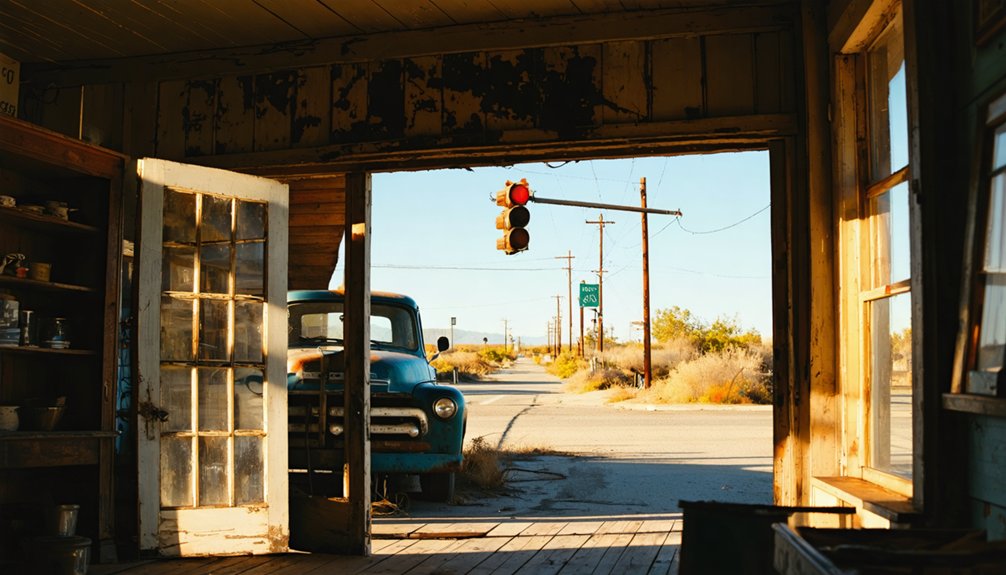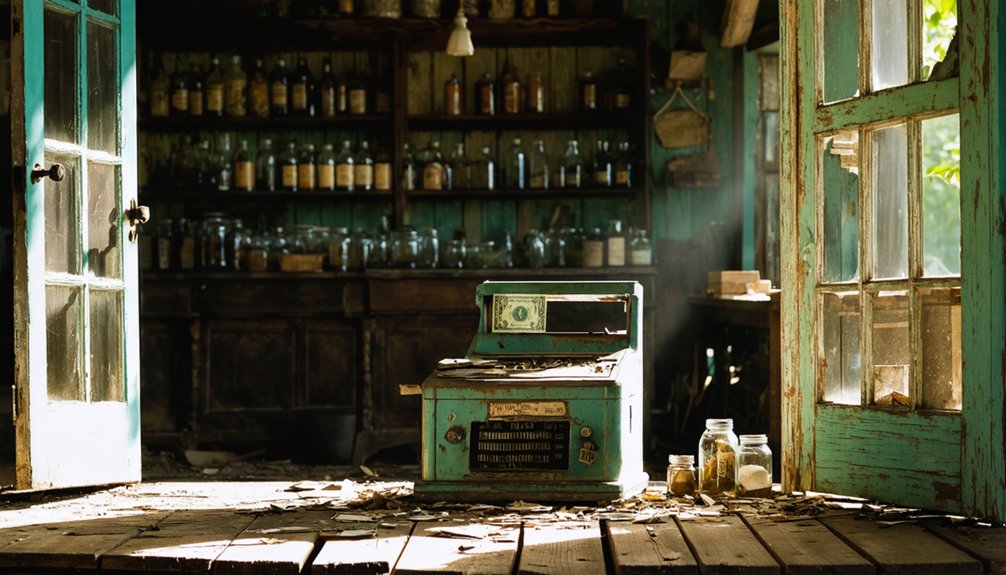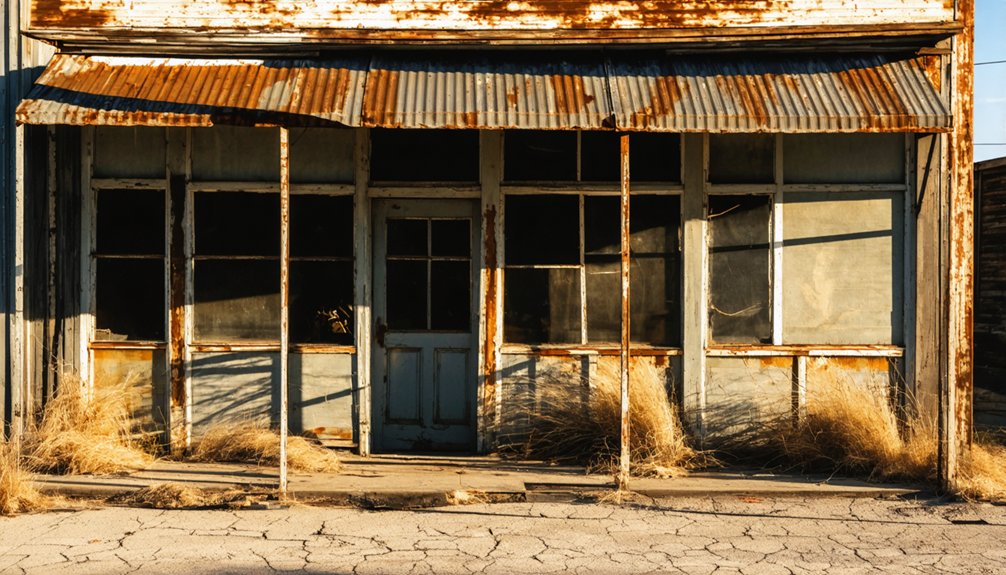You’ll find Texla along the Texas-Louisiana border, where it emerged in 1905 as a bustling lumber town during the East Texas timber boom. Originally named Bruce, the town flourished under R. W. Wier Lumber Company’s sawmill operations, with a peak population of 600 residents. Workers endured 12-hour shifts while living in company-controlled housing. Though the community’s vibrant sawmill culture eventually faded, Texla’s ghost town remains tell a compelling story of America’s industrial transformation.
Key Takeaways
- Texla was established in 1905 during the East Texas lumber boom, reaching a peak population of 600 residents.
- The town’s name combined “Texas” and “Louisiana,” reflecting its location near the state border and cross-border commerce.
- Sawmill operations dominated the town’s economy, with workers living in company-controlled housing and relying on the company store.
- The community declined when major highways were rerouted away from the area, diverting traffic and commerce.
- The closure of essential services like the post office and general store led to Texla’s eventual transformation into a ghost town.
A Timber Town’s Birth
When the East Texas lumber boom reached its peak in the early 1900s, Texla emerged as a promising new timber town in Orange County.
You’ll find its origins traced to 1905, when ambitious lumber companies recognized the area’s rich forest resources and strategic location. The timber economy quickly took root as sawmill culture transformed this piece of wilderness into a bustling community.
You would’ve witnessed the rapid development of infrastructure, particularly the essential railroad connections that served as lifelines for lumber transportation. Like other lumber towns, it relied on a tram road system to efficiently move logs from forest to mill.
The town’s establishment wasn’t just about cutting trees – it represented the broader regional expansion of East Texas’s lumber industry. Major sawmill operations sprung up, drawing workers and their families to this frontier of opportunity, where the promise of steady work in the lumber trade beckoned settlers to put down roots. The town flourished during the golden era of East Texas lumber that defined the region from the 1880s through the 1920s.
From Bruce to Texla: The Name Change Story
You’ll find the community’s original name, Bruce, honored both Charles G. Bruce, who became the first postmaster in 1905, and early settler Horatio Gates Bruce from the 1880s.
The shift to “Texla” came shortly after the post office‘s establishment, coinciding with the R. W. Wier Lumber Company’s acquisition of local operations.
Your understanding of the name change deepens when you consider how the new name cleverly combined “Texas” and “Louisiana,” reflecting the town’s strategic location near the state border and its broader regional ambitions.
The development of railroad lines in the region after 1870 helped connect the town to larger markets and facilitated the lumber trade.
The town thrived during its peak years, with six hundred residents forming a bustling lumber community.
Original Bruce Identity
The story of Texla’s original identity begins with Charles G. Bruce, who became the community’s first postmaster in 1905.
You’ll find that the Bruce legacy stretches back even further to the early 1880s when Horatio Gates Bruce first settled the area.
The community foundations were quickly established, with two churches rising by the mid-1880s.
During this period, you’d have known the settlement simply as Bruce, a name that reflected both the postmaster’s influence and the area’s early settler history.
The community thrived under this original identity, marking its place in northern Orange County near the Louisiana border. Much like today’s efforts to preserve state history, local residents worked to maintain records of their growing settlement.
This Bruce era established the groundwork for what would later become a significant lumber industry hub, though you wouldn’t have called it Texla just yet.
Post Office Name Change
After operating as Bruce for just one year, the post office underwent a significant transformation in 1906 when R. W. Wier Lumber Company acquired the operation. This marked the beginning of a new postal identity as “Texla,” a clever combination of “Texas” and “Louisiana” that perfectly captured the town’s strategic border location.
The name evolution from Bruce to Texla reflected several key changes:
- The shift from individual ownership under postmaster Charles G. Bruce to corporate management
- A broader regional identity that emphasized cross-border commerce and connections
- Strategic branding that aligned with the lumber industry’s expanding influence
Similar to how Blanco County Emergency Services District No. 1 serves its local community today, Texla was a vital service hub for the surrounding area.
The new name proved enduring, remaining throughout multiple ownership changes until the town’s decline in the late 1920s. Located along the Orange and Northwestern Railway, the town’s position made it an ideal hub for lumber transportation and commerce.
Even today, Texla’s postal identity serves as a reflection of the region’s rich lumber heritage and cross-border significance.
Border Location Impact
Located at a pivotal point between two states, Bruce’s transformation into Texla reflected more than just a simple name change – it embodied the town’s unique position as a cross-border community in the early 1900s.
The border influence shaped every aspect of the settlement’s development, from its economic foundations in the timber industry to its cultural identity. The establishment of Harrell-Votaw Lumber Company in 1905 marked the beginning of the town’s industrial growth.
You’ll find that Texla’s strategic location fostered strong economic ties across state lines, particularly in the lumber trade. The Wier Lumber Company capitalized on this position, establishing markets in both Texas and Louisiana.
The town’s regional identity emerged from this cross-border dynamic, as workers and residents from both states contributed to its character. This dual-state heritage ultimately inspired the hybrid name “Texla,” combining “Tex” from Texas and “La” from Louisiana.
Life in a Sawmill Community
You’d find sawmill workers in Texla rising before dawn for grueling 12-hour shifts, trudging from their company-owned homes to the thundering mill where massive saws sliced through East Texas pine.
Your daily wages might only stretch far enough for basic supplies at the company store, where you’d gather with fellow workers to share news and swap stories.
When Sunday came, you’d join your neighbors at makeshift gathering spots near the mill yard, perhaps for a church service or community celebration – rare breaks from the relentless pace of sawmill life. Living conditions were strictly divided, with segregated housing areas separating black and white workers in the community. The Texas South-Eastern Railroad wound through the heart of town, carrying freshly cut lumber to distant markets.
Daily Sawmill Worker Routines
While most East Texas towns were still waking up, sawmill workers in Texla were already starting their grueling workday before dawn.
You’d find yourself working eleven-hour sawmill shifts in harsh labor conditions, earning just $1.50 to $2.50 per day. If you were lucky, you’d land a skilled position like sawyer or planer, but most workers tackled backbreaking general labor.
Your daily duties would include:
- Felling and scaling massive pine trees with precision
- Setting railroad ties for the essential log transport system
- Working alongside 40-60 men under a demanding woods boss
You weren’t just a worker – you were part of a crucial operation that transformed Texas’s virgin pine forests into lumber, despite the deplorable housing and irregular paydays that came with the job.
Worker Housing and Amenities
Life in a Texla sawmill house meant living under the company’s thumb, with every aspect of your daily existence tied to the mill’s control. You’d find yourself in a basic frame house, often cramped and lacking indoor plumbing. Your neighbors’ homes would reflect the strict racial and job status hierarchy – skilled white workers got better housing while others made do with far less.
The company controlled all worker amenities, from the commissary where you’d buy overpriced supplies on credit to the basic medical care provided by company doctors. Housing conditions were typically substandard, and you’d risk eviction for speaking up or joining a union.
Even your children’s education was company-run, usually stopping at 7th grade in segregated schoolhouses. Churches offered some respite, though they too often felt the company’s influence.
Community Gathering Spaces
Despite the company’s tight control over daily life, sawmill workers found warmth and connection in Texla’s vibrant community spaces.
You’d find folks gathering at the central company store, which served as more than just a place to buy goods – it was where community interactions flourished through casual conversations and posted announcements.
The town’s social gatherings centered around these key spaces:
- The community hall, where you could join dances, meetings, and seasonal festivals
- Local churches, which hosted both worship services and community events
- The school building, doubling as a venue for everything from plays to town meetings
After long days at the mill, these gathering spots gave you a chance to strengthen bonds with neighbors, share news, and maintain a sense of independence despite company oversight.
The East Texas Lumber Boom Era
The explosive growth of railroads across East Texas in the 1880s ignited one of the region’s most transformative economic booms.
Railroad expansion in 1880s East Texas sparked an economic revolution, forever changing the region’s industrial and social landscape.
You’d have witnessed an unprecedented surge in lumber industry development as rail lines penetrated previously inaccessible pine forests, enabling efficient timber transport beyond traditional river routes.
This economic transformation peaked around 1907, when annual production soared to 2.25 billion board feet, making Texas the nation’s third-largest lumber producer.
You’d have seen massive steam-powered mills churning out 25,000 board feet daily, while over 300 tramlines crisscrossed the forests.
Wealthy lumber kings emerged, building company towns complete with housing and stores.
Daily Operations & Industry

During Texla’s heyday, massive steam-powered sawmills dominated the town’s industrial landscape, processing thousands of board feet daily from East Texas pine forests.
You’d find a tightly controlled operation where timber processing never seemed to stop, with crews rotating shifts year-round to meet the lumber boom’s intense demands.
The company’s iron grip extended beyond the sawmills into every aspect of daily life:
- You’d live in company housing, shop at company stores, and spend your leisure time in company-sponsored venues like the opera house or bandstand.
- Your movements were restricted by barbed wire and guards to prevent union organizing.
- You’d rely on company-operated railroads that connected the sawmills to logging sites and distribution centers.
These operations continued until timber depletion and economic shifts ultimately led to Texla’s decline by the late 1910s.
Living on the Texas-Louisiana Border
Along the meandering Sabine River, which carved out the Texas-Louisiana border after the Adams-Onís Treaty of 1819, you’d find communities whose identities blended both states’ cultures and histories.
Towns like Latex and Texla emerged as symbols of cultural exchange, where your property lines might run north-south or east-west, following American survey patterns that replaced the old Spanish system.
You’d discover a rich regional identity in these border settlements, where African American farmers established new lives after the Civil War.
The boundary marker at Logansport still stands as a monument to your frontier heritage, while small farming communities maintained their own schools and cemeteries.
Living here meant embracing both states’ influences, creating a unique borderland culture that defied simple state loyalties.
The Town’s Gradual Decline

While railroads once brought prosperity to Texla during the early 1900s, shifting economic patterns gradually stripped the town of its liveliness.
You’ll find that Texla’s decline mirrored many border communities that couldn’t adapt to changing times. The town’s economic adaptation proved challenging as the region’s agricultural and timber industries waned.
By the mid-20th century, Texla faced several critical blows to its community resilience:
- The rerouting of major highways diverted traffic and commerce away from local businesses
- Young families moved to larger cities for better opportunities, leaving an aging population
- The closure of essential services like the post office and general store accelerated the exodus
Without its railroad lifeline and unable to diversify its economy, Texla’s transformation from a bustling border town to a ghost town became inevitable.
What Remains Today
If you visit Texla today, you’ll find nature has largely reclaimed what little remains of this forgotten community.
Like many Texas ghost town remnants, only scattered foundations and deteriorating structures mark where buildings once stood. You’ll encounter overgrown paths where streets used to be, while local wildlife now claims the abandoned lots as their domain.
No businesses operate here, and you won’t find any maintained infrastructure or public services.
The site’s ghost town remnants tell a familiar story of Texas history: a once-hopeful settlement returned to wilderness. While some visitors occasionally document their explorations on social media, Texla stands as another example of the state’s numerous abandoned communities, with its artifacts scattered to private collections or lost to time.
Access remains limited, and ownership questions linger over the property.
Historical Significance in East Texas

The historical footprint of Texla extends far beyond its abandoned remnants, telling a broader story of East Texas’s economic transformation in the early 1900s.
You’ll find its timber legacy woven into the fabric of regional development, representing countless communities that rose and fell with the rhythms of resource extraction.
- Like many boom towns, Texla’s story showcases the raw entrepreneurial spirit that drove East Texas’s industrial expansion.
- The town’s brief but impactful existence demonstrates how natural resources shaped settlement patterns across the region.
- Despite its eventual decline, Texla’s community resilience during the timber boom contributed to the foundation of modern East Texas.
When you explore Texla’s history, you’re witnessing a microcosm of the broader economic forces that transformed East Texas from wilderness to industrial heartland.
Frequently Asked Questions
Were There Any Schools or Churches Established in Texla?
While sawmills hummed and timber fell, you won’t find records of schools established or churches built during Texla’s brief existence. The company town focused purely on industry before fading into Texas history.
What Was the Average Wage for Sawmill Workers in Texla?
You’d have found sawmill wages in Texla ranging from $1.50 to $2.50 per day during the early 1900s, with worker conditions marked by long 11-hour days and unreliable payment schedules.
Did Any Other Industries Attempt to Establish Themselves in Texla?
You’d think everyone wanted a piece of Texla’s pie, but records don’t show significant agricultural developments or mining ventures taking root there. The town remained primarily focused on lumber operations until its decline.
Were There Any Notable Accidents or Tragedies in Texla’s Sawmill?
While you’ll find no specific records of sawmill accidents at Texla, worker safety was notoriously poor in East Texas mills during 1880-1910, suggesting Texla’s workers likely faced similar dangerous conditions.
Did Any Famous People or Historical Figures Ever Visit Texla?
You won’t find records of famous visitors or historical significance in Texla. The small lumber town didn’t attract notable figures before its decline, unlike larger East Texas settlements during that era.
References
- https://www.southernthing.com/ruins-in-texas-2640914879.html
- https://texashighways.com/travel-news/four-texas-ghost-towns/
- https://authentictexas.com/texas-ghost-towns/
- https://www.youtube.com/watch?v=phjUE19A8HM
- https://discovertexasoutdoors.com/places/texla-texas-abandoned-ghost-town-of-the-east-texas-timber-boom/
- https://www.texasescapes.com/TexasGulfCoastTowns/Texla-Texas.htm
- https://www.tshaonline.org/handbook/entries/tesla-tx
- https://www.sfasu.edu/heritagecenter/9885.asp
- http://www.wtblock.com/MIlltowns.htm
- https://www.tshaonline.org/handbook/entries/timber-tx



